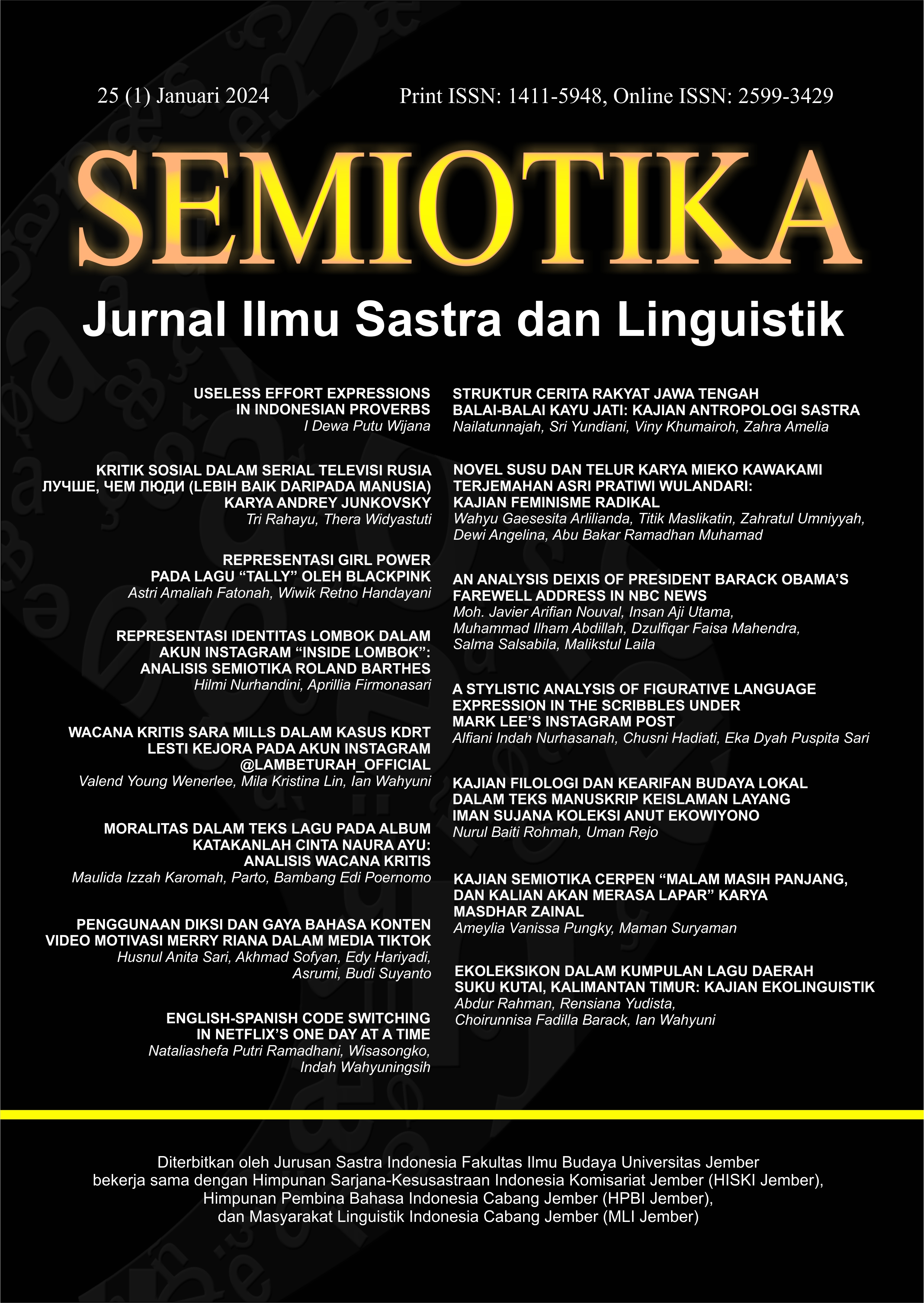REPRESENTASI GIRL POWER PADA LAGU “TALLY†OLEH BLACKPINK
DOI:
https://doi.org/10.19184/semiotika.v25i1.40355Keywords:
Blackpink, Girl Power, representation, TallyAbstract
A patriarchal culture dominated the representation of social reality, resulting in women's victimization. However, now the media is highlighting women in terms of educational achievements, so the existence of independent women is increasing. This research aims to discuss the representation of Girl Power shown in the video clip and lyrics of the song "Tally" by Blackpink. The research is based on qualitative methods with John Fiske's theoretical concepts of semiotics and Sara Mills' critical discourse analysis. The study results show that the video clip and lyrics of the song "Tally" by Blackpink represent Girl Power. The women depicted by Blackpink are strong. The ideology displayed stands out and is by the spirit of postfeminism that women's bodies cannot be used as objects and cannot be owned by men. Women's bodies and feelings can only be controlled by women without men's interference.
Downloads
References
Arivia, G. 2006. Feminisme: Sebuah Kata Hati. Penerbit Buku Kompas.
Braithwaite, A. 2004. “Politics of/and Backlash. Journal of International Women’s Studiesâ€, 5 (5), 18-33. Available at: https://vc.bridgew.edu/jiws/vol5/iss5/2.
Djajasudarma, T. F. 2010. Metode Linguistik. Bandung: PT Refika Aditama.
Fiske, J. 2011. Introduction to Communication Studies 3 rded. New York, NY: Routledge.
Fiske, J. 1987. Television Culture. London: Routledge.
Fiske, J. 2007. Cultural and Communication Studies. Yogyakarta: Jalasutra.
Hall, S. 1997. Representation: Cultural Representation and Signifying Practices. London: Sage Publications.
Kellner, D. 2010. Budaya Media: Cultural Studies, Identitas, dan Politik: Antara Modern dan Postmodern. Jalasutra.
Miles, M.B,, Huberman, A. M, & Saldana, J. 2014. Qualitative Data Analysis, A Methods Sourcebook, Edition 3. USA: Sage Publications. Terjemahan Rohidi, Tj.R. Jakarta: UI-Press.
Mills, S. 1995. Feminist Stylistic. Oxfordshire: Routledge.
Piliang, Y. A. 2012. Semiotika dan Hipersemiotika: Kode, Gaya & Matinya Makna. Bandung: Matahari.
Rokhmansyah, A. 2016. Pengantar Gender dan Feminisme: Pemahaman Awal Kritik Sastra Feminis. Yogyakarta: Garudhawaca.
Sonara.Id. 2023. “30 Peringkat Girl Group K-pop Terpopuler Februari 2021, BLACKPINK Belum Tergeser!â€. Di https://www.sonora.id/read/422554181/30-peringkat-girl-group-k-pop-terpopuler-februari-2021-blackpink-belum-tergeser. Diakses 4 April 2023.
Sunarto, T. 2009. “Kekerasan, dan Perempuanâ€. Jakarta: Kompas Media Nusantara.
Tirto.Id. 2023. “Konsep Girl Crush dalam Industri K-Pop, dari Blackpink Hingga 2NE1â€. Di https://tirto.id/konsep-girl-crush-dalam-industri-k-pop-dari-blackpink-hingga-2ne1-deT9. Diakses 4 April 2023.
Tong, R. P. 2010. Feminist Thought. Terjemahan Aquarini. Yogyakarta: Jalasutra.
Zuhaira, S. 2021. “Representasi Perempuan Dalam Video Klip Girlband Korea (Analisis Semiotika Video Klip Dalla Dalla Dari Girlband Itzyâ€. Mediakita, 5(2):170—186.
Downloads
Published
Issue
Section
License
SEMIOTIKA has CC-BY-SA or an equivalent license as the optimal license for the publication, distribution, use, and reuse of scholarly work. Authors who publish with this journal retain copyright and grant the journal right of first publication with the work simultaneously licensed under a Creative Commons Attribution-ShareAlike 4.0 International License that allows others to share the work with an acknowledgment of the work's authorship and initial publication in this journal.
Attribution-ShareAlike
CC BY-SA


